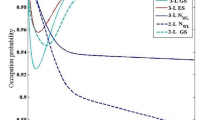Abstract
A circuit model of a quantum dot semiconductor optical amplifier is proposed by employing standard rate equations. Using this model, the saturation property and dynamic performance of the quantum dot semiconductor optical amplifier are analyzed by PSPICE simulation. We also investigate wavelength conversion based on cross-gain modulation for the quantum dot semiconductor optical amplifier. The corresponding results are in agreement with the previous published works.
Similar content being viewed by others
References
Asada M, Miyamoto Y, Suematsu Y. Gain and the threshold of three-dimensional quantum-box lasers. IEEE Journal of Quantum Electronics, 1986, QE-22(9): 1915–1921
Willatzen M, Tanaka T, Arakawa Y, Singh J. Polarization dependence of optoelectronic properties in quantum dots and quantum wires-consequences of valence-band mixing. IEEE Journal of Quantum Electronics, 1994, 30(3): 640–653
Bhattacharya P. Self-organized quantum dots. Journal of Physics D, 2005, 38(13): 2055–2150
Huang X, Stintz A, Li H, Lester L F, Cheng J, Malloy K J. Passive mode-locking in 1.3 μm two-section InAs quantum dot lasers. Applied Physics Letters, 2001, 78(19): 2825–2827
Ben-Ezra Y, Haridim M, Lembrikov B I. Theoretical analysis of gain-recovery time and chirp in QD-SOA. IEEE Photonics Technology Letters, 2005, 17(19): 1803–1805
Li X X, Li G F. Comments on “theoretical analysis of gain-recovery time and chirp in QD-SOA”. IEEE Photonics Technology Letters, 2006, 18(22): 2434–2435
Huang L R, Yu Y, Tian P, Huang D X. Polarization-insensitive quantum-dot coupled quantum-well semiconductor optical amplifier. Semiconductor Science and Technology, 2009, 24(1): 1–7
Li X X, Li G F. Static gain, optical modulation response, and nonlinear phase noise in saturated quantum-dot semiconductor optical amplifiers. IEEE Journal of Quantum Electronics, 2009, 45(5): 499–505
Uskov A V, O’Reilly E P, Laemmlin M, Ledentsov N N, Bimberg D. On gain saturation in quantum dot semiconductor optical amplifiers. Optics Communications, 2005, 248(1–3): 211–219
Sugawara M, Mukai K, Nakata Y, Ishikawa H, Sakamoto A. Effect of homogeneous broadening of optical gain on lasing spectra in selfassembled InxGa1−x As/GaAs quantum dot lasers. Physical Review B: Condensed Matter and Materials Physics, 2001, 61(11): 7595–7603
Manning R J, Ellis A D, Poustie A J, Blow K J. Semiconductor laser amplifiers for ultrafast all-optical signal processing. Journal of the Optical Society of America B: Optical Physics, 1997, 14(11): 3204–3216
Cotter D, Manning R J, Blow K J, Ellis A D, Kelly A E, Nesset D, Phillips I D, Poustie A J, Rogers D C. Nonlinear optics for high speed digital information processing. Science, 1999, 286(5444): 1523–1528
Mena P V, Kang S M, Temple T A D. Rate-equation-based laser models with a single solution regime. Journal of Lightwave Technology, 1997, 15(4): 717–730
Mena P V. Circuit-level modeling and simulation of semiconductor lasers. Dissertation for the Doctoral Degree, University of Illinois at Chicago, 1998
Jou J J, Liu C K, Lee S L. A unified circuit model for static and dynamic analyses of semiconductor optical amplifiers and laser diodes. Solid-State Electronics, 2007, 51(3): 360–365
Lu M F, Deng J S, Juang C, Jou M J, Lee B J. Equivalent circuit model of quantum well lasers. IEEE Journal of Quantum Electronics, 1995, 31(8): 418–1422
Yavari M H, Ahmadi V. Circuit-level implementation of semiconductor self-assembled quantum dot laser. IEEE Journal on Selected Topics in Quantum Electronics, 2009, 15(3): 774–779
Maram R, Baghban H, Rasooli H, Ghorbani R, Rostami A. Equivalent circuit model of quantum dot semiconductor optical amplifiers: dynamic behaviour and saturation properties. Journal of Optics A: Pure and Applied Optics, 2009, 11(10): 105205
Gioannini M, Montrosset I. Numerical analysis of the frequency chirp in quantum-dot semiconductor lasers. IEEE Journal of Quantum Electronics, 2007, 43(10): 941–949
Berg T W, Bischoff S, Magnusdottir I, Mork J. Ultrafast gain recovery and modulation limitations in self-assembled quantum-dot devices. IEEE Photonics Technology Letters, 2001, 13(6): 541–543
Ben-Ezra Y, Lembrikov B I, Haridim M. Acceleration of gain recovery and dynamics of electrons in QD-SOA. IEEE Journal of Quantum Electronics, 2005, 41(10): 1268–1273
Kim J, Kondratko P K, Chuang S L, Walter G, Holonyak N, Heller R D, Zhang X B, Dupuis R D. Tunneling injection quantum-dot lasers with polarization-dependent photon-mediated carrier redistribution and gain narrowing. IEEE Journal of Quantum Electronics, 2005, 41(11): 1369–1379
Houbavlis T, Zoiros K E, Kalyvas M, Theophilopoulos G, Bintjas C, Yiannopoulos K, Pleros N, Vlachos K, Avramopoulos H, Schares L, Occhi L, Guekos G, Taylor J R, Hansmann S, Miller W. Alloptical signal processing and applications within the esprit project DO_ALL. Journal of Lightwave Technology, 2005, 23(2): 781–801
Uskov A V, Mork J, Tromborg B, Berg T W, Magnusdottir I, O’Reilly E P. On high-speed cross-gain modulation without pattern effects in quantum dot semiconductor optical amplifiers. Optics Communications, 2003, 227(4–5): 363–369
Kim J, Laemmlin M, Meuer C, Bimberg D, Eisenstein G. Theoretical and experimental study of high-speed small-signal cross-gain modulation of quantum-dot semiconductor optical amplifiers. IEEE Journal of Quantum Electronics, 2009, 45(3): 240–248
Author information
Authors and Affiliations
Corresponding author
Rights and permissions
About this article
Cite this article
Yu, Y., Huang, L., Xiong, M. et al. Circuit modeling of quantum dot semiconductor optical amplifier. Front. Optoelectron. China 3, 232–240 (2010). https://doi.org/10.1007/s12200-010-0101-1
Received:
Accepted:
Published:
Issue Date:
DOI: https://doi.org/10.1007/s12200-010-0101-1




